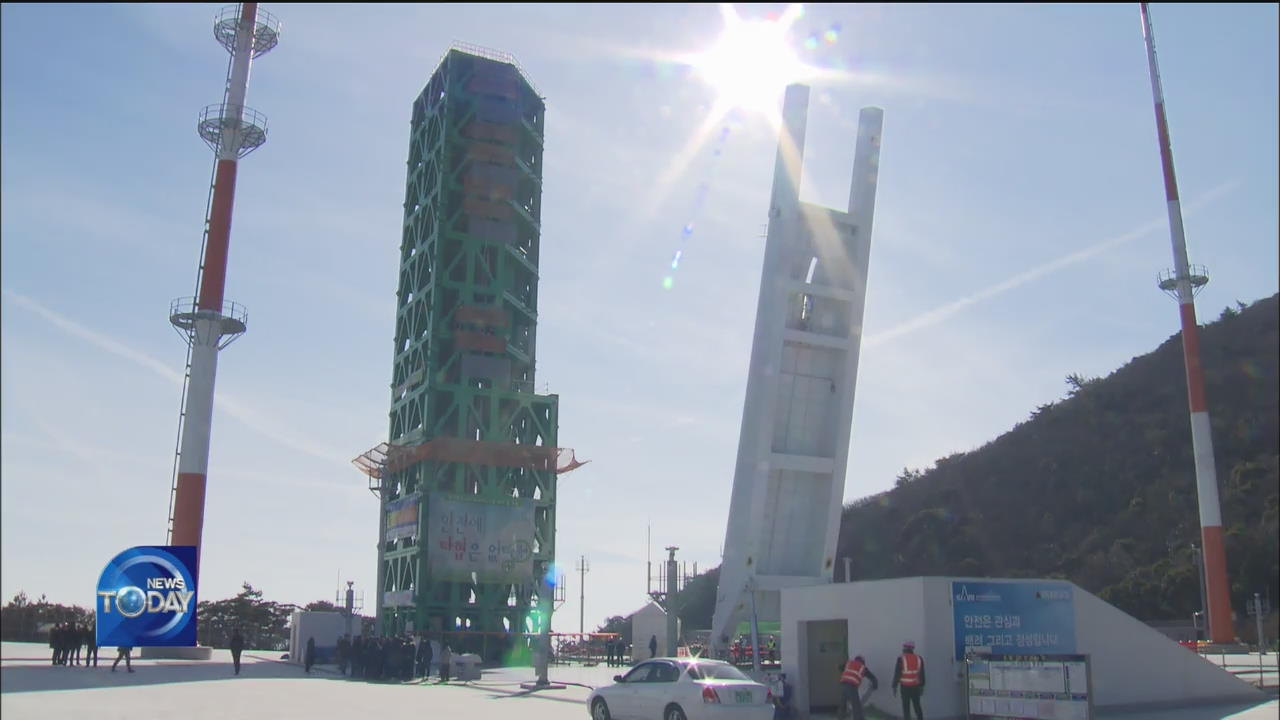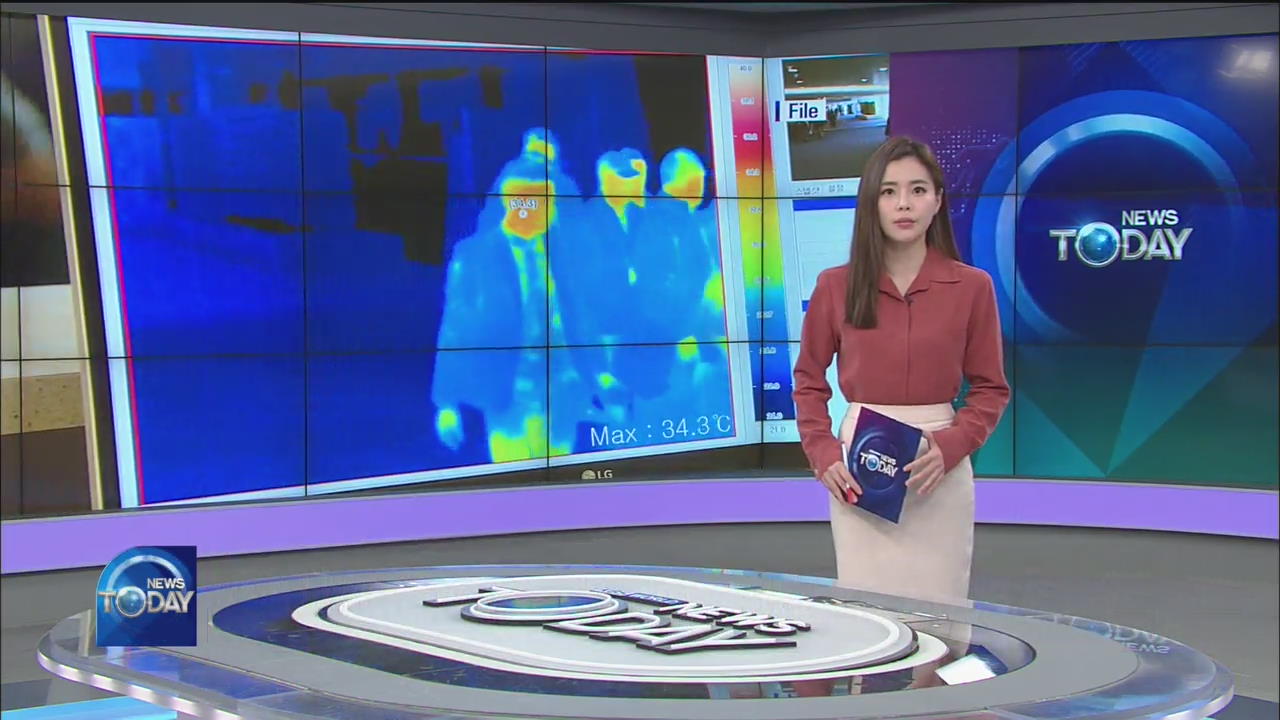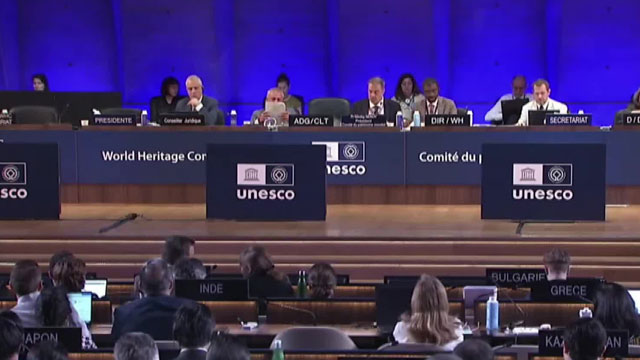DEVELOPMENT PROCESS OF LOCAL ROCKET
입력 2020.01.20 (15:04)
수정 2020.01.20 (16:45)
읽어주기 기능은 크롬기반의
브라우저에서만 사용하실 수 있습니다.
[Anchor Lead]
The development process of a locally-developed space rocket has been made public with its launch scheduled for next year. An engine combustion test has been going smoothly so far and a launch tower has also been set up.
[Pkg]
A flurry of grey smoke rises high into the sky with a roaring sound. This moment confirms the success of the 139th ground combustion test for a 75-ton engine that will be used in the home-made space launch vehicle "Nuri." Nuri, wholly designed and developed with domestic technology, is a three-stage rocket that can reach an altitude of 600 to 800 kilometers and put a 1.5-ton satellite into orbit. Since the successful first test launch in November 2018, follow-up development programs have been going as planned. The key task for this year is to conduct a comprehensive combustion test for a cluster of four 75-ton engines. The part is the largest and most critical, since it is installed in the space rocket's first stage, which will be used for the initial launch.
[Soundbite] GOH JEONG-HWAN(KOREA AEROSPACE RESEARCH INSTITUTE) : "It plays a crucial role of sending the 200-ton Nuri rocket to an altitude of 55 meters. The stable operation of the first stage is important."
The construction of the second launch pad for Nuri is now in full swing and is scheduled to be completed by October this year. Currently, it is 93 percent complete. A 45.6 meter-tall tower has been set up to launch Nuri, which is far bigger than the previous two-stage vehicle "Naro," which was fired in 2013.
[Soundbite] KANG SUN-IL(KOREA AEROSPACE RESEARCH INSTITUTE) : "Pipes and electric wires must be connected to supply propellants. Our researchers work on the wiring up at the tower."
The government plans to launch a lunar probe on a locally developed space rocket by 2030 if the development of Nuri is successful.
The development process of a locally-developed space rocket has been made public with its launch scheduled for next year. An engine combustion test has been going smoothly so far and a launch tower has also been set up.
[Pkg]
A flurry of grey smoke rises high into the sky with a roaring sound. This moment confirms the success of the 139th ground combustion test for a 75-ton engine that will be used in the home-made space launch vehicle "Nuri." Nuri, wholly designed and developed with domestic technology, is a three-stage rocket that can reach an altitude of 600 to 800 kilometers and put a 1.5-ton satellite into orbit. Since the successful first test launch in November 2018, follow-up development programs have been going as planned. The key task for this year is to conduct a comprehensive combustion test for a cluster of four 75-ton engines. The part is the largest and most critical, since it is installed in the space rocket's first stage, which will be used for the initial launch.
[Soundbite] GOH JEONG-HWAN(KOREA AEROSPACE RESEARCH INSTITUTE) : "It plays a crucial role of sending the 200-ton Nuri rocket to an altitude of 55 meters. The stable operation of the first stage is important."
The construction of the second launch pad for Nuri is now in full swing and is scheduled to be completed by October this year. Currently, it is 93 percent complete. A 45.6 meter-tall tower has been set up to launch Nuri, which is far bigger than the previous two-stage vehicle "Naro," which was fired in 2013.
[Soundbite] KANG SUN-IL(KOREA AEROSPACE RESEARCH INSTITUTE) : "Pipes and electric wires must be connected to supply propellants. Our researchers work on the wiring up at the tower."
The government plans to launch a lunar probe on a locally developed space rocket by 2030 if the development of Nuri is successful.
■ 제보하기
▷ 카카오톡 : 'KBS제보' 검색, 채널 추가
▷ 전화 : 02-781-1234, 4444
▷ 이메일 : kbs1234@kbs.co.kr
▷ 유튜브, 네이버, 카카오에서도 KBS뉴스를 구독해주세요!
- DEVELOPMENT PROCESS OF LOCAL ROCKET
-
- 입력 2020-01-20 15:01:21
- 수정2020-01-20 16:45:53

[Anchor Lead]
The development process of a locally-developed space rocket has been made public with its launch scheduled for next year. An engine combustion test has been going smoothly so far and a launch tower has also been set up.
[Pkg]
A flurry of grey smoke rises high into the sky with a roaring sound. This moment confirms the success of the 139th ground combustion test for a 75-ton engine that will be used in the home-made space launch vehicle "Nuri." Nuri, wholly designed and developed with domestic technology, is a three-stage rocket that can reach an altitude of 600 to 800 kilometers and put a 1.5-ton satellite into orbit. Since the successful first test launch in November 2018, follow-up development programs have been going as planned. The key task for this year is to conduct a comprehensive combustion test for a cluster of four 75-ton engines. The part is the largest and most critical, since it is installed in the space rocket's first stage, which will be used for the initial launch.
[Soundbite] GOH JEONG-HWAN(KOREA AEROSPACE RESEARCH INSTITUTE) : "It plays a crucial role of sending the 200-ton Nuri rocket to an altitude of 55 meters. The stable operation of the first stage is important."
The construction of the second launch pad for Nuri is now in full swing and is scheduled to be completed by October this year. Currently, it is 93 percent complete. A 45.6 meter-tall tower has been set up to launch Nuri, which is far bigger than the previous two-stage vehicle "Naro," which was fired in 2013.
[Soundbite] KANG SUN-IL(KOREA AEROSPACE RESEARCH INSTITUTE) : "Pipes and electric wires must be connected to supply propellants. Our researchers work on the wiring up at the tower."
The government plans to launch a lunar probe on a locally developed space rocket by 2030 if the development of Nuri is successful.
The development process of a locally-developed space rocket has been made public with its launch scheduled for next year. An engine combustion test has been going smoothly so far and a launch tower has also been set up.
[Pkg]
A flurry of grey smoke rises high into the sky with a roaring sound. This moment confirms the success of the 139th ground combustion test for a 75-ton engine that will be used in the home-made space launch vehicle "Nuri." Nuri, wholly designed and developed with domestic technology, is a three-stage rocket that can reach an altitude of 600 to 800 kilometers and put a 1.5-ton satellite into orbit. Since the successful first test launch in November 2018, follow-up development programs have been going as planned. The key task for this year is to conduct a comprehensive combustion test for a cluster of four 75-ton engines. The part is the largest and most critical, since it is installed in the space rocket's first stage, which will be used for the initial launch.
[Soundbite] GOH JEONG-HWAN(KOREA AEROSPACE RESEARCH INSTITUTE) : "It plays a crucial role of sending the 200-ton Nuri rocket to an altitude of 55 meters. The stable operation of the first stage is important."
The construction of the second launch pad for Nuri is now in full swing and is scheduled to be completed by October this year. Currently, it is 93 percent complete. A 45.6 meter-tall tower has been set up to launch Nuri, which is far bigger than the previous two-stage vehicle "Naro," which was fired in 2013.
[Soundbite] KANG SUN-IL(KOREA AEROSPACE RESEARCH INSTITUTE) : "Pipes and electric wires must be connected to supply propellants. Our researchers work on the wiring up at the tower."
The government plans to launch a lunar probe on a locally developed space rocket by 2030 if the development of Nuri is successful.
이 기사가 좋으셨다면
-
좋아요
0
-
응원해요
0
-
후속 원해요
0












![[속보] 내란특검 “서울구치소에 오후 2시까지 윤석열 전 대통령 3차 인치 지휘”](/data/layer/904/2025/07/20250716_5Lxha9.jpg)
![[속보] 순직 해병 특검 “오늘 오후 박정훈 대령 참고인 조사”](/data/layer/904/2025/07/20250716_MUM2IP.jpg)
![[속보] 경찰·노동부, ‘인천 맨홀 사망’ 인천환경공단 등 압수수색](/attach/image/2025/03/23/20250323_8Sjy5d.jpg)


이 기사에 대한 의견을 남겨주세요.